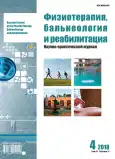Магнитотерапия у больных остеоартрозом коленных суставов: термографические показатели эффективности
- Авторы: Герасименко М.Ю.1, Глушкова Е.П.2, Горбунова Д.Ю.2, Бяловский Ю.Ю.3, Булатецкий С.В.3, Иванов А.В.4
-
Учреждения:
- Российская медицинская академия непрерывного профессионального образования
- Клинический госпиталь Медико-санитарной части МВД России по Рязанской области
- Рязанский государственный медицинский университет имени академика И.П. Павлова
- Елатомский приборный завод
- Выпуск: Том 17, № 4 (2018)
- Страницы: 185-191
- Раздел: Оригинальные исследования
- URL: https://journals.rcsi.science/1681-3456/article/view/33838
- DOI: https://doi.org/10.18821/1681-3456-2018-17-4-185-191
- ID: 33838
Цитировать
Полный текст
Аннотация
Обоснование. Остеоартроз характеризуется широкой распространенностью, особенно среди лиц старших возрастных групп, высоким риском развития ограничений функции опорно-двигательного аппарата, которые приводят к нарушению трудоспособности и снижению качества жизни пациентов. Цель — изучить возможности термографической оценки эффективности магнитотерапии суставного синдрома при остеоартрозе коленных суставов.
Методы. В исследовании участвовало 57 пациентов с остеоартрозом коленных суставов, из них 46 женщин и 11 мужчин (средний возраст 61,2±7,4 года). Больные были разделены на две группы: в первой группе (n=29) использовалась магнитотерапия аппаратом «АЛМАГ-01», во второй (n=28) — аппарат-плацебо.
Результаты. Включение метода магнитотерапии в комплексное лечение остеоартроза коленных суставов существенно повышает, по термографическим данным, его эффективность и значительно отличается от плацебо-процедур. У пациентов с остеоартрозом коленных суставов I и II рентгенологических стадий при сочетании курсового лечения бегущим импульсным магнитным полем и стандартной медикаментозной терапии выявлена положительная динамика температурного баланса суставов. У пациентов с остеоартрозом I рентгенологической стадии выявлена минимальная эффективность магнитотерапии по данным термографии, что указывает на низкую выраженность воспалительного суставного синдрома.
Заключение. Метод инфракрасной термографии можно использовать в качестве диагностической методики, отражающей степень активности воспалительного процесса в суставах при остеоартрозе.
Ключевые слова
Полный текст
Открыть статью на сайте журналаОб авторах
М. Ю. Герасименко
Российская медицинская академия непрерывного профессионального образования
Email: b_uu@mail.ru
ORCID iD: 0000-0002-1741-7246
Россия, Москва
Е. П. Глушкова
Клинический госпиталь Медико-санитарной части МВД России по Рязанской области
Email: b_uu@mail.ru
ORCID iD: 0000-0003-4677-8507
Россия, Рязань
Д. Ю. Горбунова
Клинический госпиталь Медико-санитарной части МВД России по Рязанской области
Email: b_uu@mail.ru
ORCID iD: 0000-0002-8232-2753
Россия, Рязань
Ю. Ю. Бяловский
Рязанский государственный медицинский университет имени академика И.П. Павлова
Email: b_uu@mail.ru
ORCID iD: 0000-0002-6769-8277
д.м.н., профессор
Россия, РязаньС. В. Булатецкий
Рязанский государственный медицинский университет имени академика И.П. Павлова
Автор, ответственный за переписку.
Email: b_uu@mail.ru
ORCID iD: 0000-0002-6023-7523
Россия, Рязань
А. В. Иванов
Елатомский приборный завод
Email: b_uu@mail.ru
ORCID iD: 0000-0001-5961-892X
Россия, Елатьма
Список литературы
- Бодрова А.И., Бяловский Ю.Ю., Иванов А.В., Ларинский Н.Е. Экономическая целесообразность включения магнитотерапии в комплексное лечение остеоартроза. Врач. 2014;(4):59–63.
- Бяловский Ю.Ю., Иванов А.В., Ракита Д.Р. Оптимизация магнитотерапевтического воздействия при лечении остеоартроза. Врач. 2016;(3):75–78.
- Голованова М.В., Потехина Ю.П. Возможности термодиагностики в медицине. Н. Новгород; 2011. 164 с.
- Иваницкий Г.P., Xижняк Е.П., Деев А.А. Биофизические основы медицинского тепловидения. Биофизика. 2012;57(1):130–139.
- Козлов А.В., Сонькин В.Д., Якушкин А.В. Метод исследования активности подкожных термогенных структур при действии стимулов разной модальности. Физиология человека. 2017;43(6):124–134. doi: 10.7868/S0131164617060030.
- Щурова Е.Н., Макушин В.Д., Бирюкова М.Ю., и др. Особенности микроциркуляции в субхондральной области эпифиза большеберцовой кости у больных гонартрозом. Регионарное кровообращение и микроциркуляция. 2012;11(4):35–40. doi: 10.24884/1682-6655-2012-11-4-35-40.
- Altman R, Asch E, Bloch D, et al. Development of criteria for the classification and reporting of osteoarthritis. Classification of osteoarthritis of the knee. Diagnostic and Therapeutic Criteria Committee of the American Rheumatism Association. Arthritis Rheum. 1986;29(8):1039–1049. doi: 10.1002/art.1780290816.
- de Kleijn S, Ferwerda G, Wiese M, et al. A short-term extremely low frequency electromagnetic field exposure increases circulating leukocyte numbers and affects HPA-axis signaling in mice. Bioelectromagnetics. 2016;37(7):433–443. doi: 10.1002/bem.21998.
- Barnaba SA, Ruzzini L, Di Martino A, et al. Clinical significance of different effects of static and pulsed electromagnetic fields on human osteoclast cultures. Rheumatol Int. 2012;32(4):1025–1031. doi: 10.1007/s00296-010-1724-7.
- Tang R, Xu Y, Ma F, et al. Extremely low frequency magnetic fields regulate differentiation of regulatory T cells: potential role for ROS-mediated inhibition on AKT. Bioelectromagnetics. 2016;37(2):89–98. doi: 10.1002/bem.21954.
- Keen HI, Lavie F, Wakefield RJ, et al. The development of a preliminary ultrasonographic scoring system for features of hand osteoarthritis. Ann Rheum Dis. 2008;67(5):651–655. doi: 10.1136/ard.2007.077081.
Дополнительные файлы










